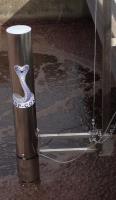 Add My Company
Add My Company
Sign In

The Benefits of Using an ASP-CON in Wastewater Treatment Plants.
Background
This information sheet is written to introduce the ASP-C0N product, highlight its capability and give some examples and case studies of outputs achieved during the instrument’s proving trials in several varying types of plant installations.
Technology Introduction.
Sensors in the wastewater treatment industry rapidly lose their effectiveness due to fouling and calibration drift. The ASP-CON has been designed to be fully self-cleaning and self-calibrating. The picture shows how after several weeks in a highly challenging aeration basin the sensor heads remain very clean. This is mainly due to the action of the medium pressure wipers but also the use of a slightly acidic flush followed by a slightly basic flush during the auto-calibration of the sensors.
The ASP-CON is a multi-sensor instrument measuring over 16 important Wastewater treatment control parameters in one unit. These are detailed below
Parameters used to directly control WWTP set-up
1) DO – Dissolved Oxygen is used as a control parameter to control airflow to the basin.
2) Ammonium – used as a control parameter or a monitor.
3) MLSS – plants run to target Mixed Liqour Suspended Solids levels –
the measure is used to increase or decrease wasting rates.
4) SVI – Settlement Volume Index - used to monitor plant performance and an indicator of Final Settlement Tank (FST) issues.
5) SSVI – considered a more indicative measure than SVI by some operators.
6) TSS – Predicted – we measure the turbidity of the SVI test supernatant. This will indicate if there is likely to be a clean or dirty discharge. It is not an exact measure as we cannot account for the FST design.
7) pH- plants have discharge consents for this measure and nitrification improves in alkaline conditions
8) Temperature – required for DO calibration but also an important parameter in Nitrifying plants as the nitrification rate is strongly affected during winter conditions.
Parameters used in advance control and monitoring regimes
9) OUR – Oxygen Uptake Rate - this is a measure of bacterial loading at the point of sampling – low figure indicates biodegradation complete or toxicity.
10) SOUR – Specific Oxygen Uptake Rate – is a measure of bacterial health, changes can indicate chronic toxicity – advanced control systems use it for loading control on plant
11) % Nitrification- measures % of SOUR used for Ammonia removal – measure of nitrification health
12) F: M ratio- some plants load their treatment works to work on specified F:M (Food: Mass) ratios – not common but is used as a diagnostic tool by process engineers.
13) Critical Carbonaceous DO level – point at which BOD removal is maximised and below which extended running should not occur as risk of sludge bulking and foaming increases.
14) Critical Nitrification DO level – point at which Ammonia removal is maximised and allows the control system to remove the required level of Ammonia without over-treating.
Plant Protection Parameters.
15) Toxicity- impact that an influent will have on bacterial health. This is determined in the inlet zone only by a matrix analysis simultaneously considering OUR , Ammonium & Flow (if available)
And Finally
16) Potassium- measured because it interferes with the Ammonia measurement.
The unit goes into the activated sludge part of the secondary treatment process.
1) In the inlet or anoxic zone it can measure influent loading and act as a feed forward control sensor.
2) In the lane itself it can act as a very accurate controller to ensure control parameter target set points such as DO are being met correctly. If far enough down the lane you can complete SVI measures.
3) In the outlet sections it can measure compliance performance.
For more information on The Benefits of Using an ASP-CON in Wastewater Treatment Plants talk to Strathkelvin Instruments Limited
Enquire Now
List your company on FindTheNeedle.

